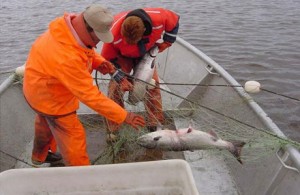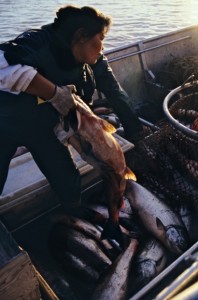Research on Chinook Run Timing
Known for navigating the longest annual freshwater migration route of any salmon to reach their spawning grounds, Chinook salmon can start arriving on the Yukon River delta at almost any point in June. Traditional knowledge on the Yukon holds that spring weather conditions, including ice, temperatures and wind determine when in June the fish enter the river, but each spring brings a different combination of conditions, so pinning down a schedule for the arrival of the first pulse can be tricky. Over the past 50 years the first pulse of Chinook on the Yukon delta has occurred sometime between the 6th and the 26th of June. While 20 days doesn’t sound like a long time to wait, it can seem like forever when the size of the winter’s salmon supply hangs in the balance.
What’s so important about getting the timing right?
Management of the Chinook salmon fishery is closely linked to expected time of arrival in harvest areas. When the migration begins earlier than expected, it’s reasonable for fishery managers to conclude that the run is stronger than it actually is, possibly resulting in over-harvesting near the river’s mouth and loss of harvest opportunities upriver. Likewise, in years when the first pulse of fish comes late, it is reasonable for fishery managers to conclude that the run is very weak, perhaps so weak that fishing needs to be slowed or stopped altogether.
Partnering to improve predictions
Over the past four years, a joint research project between NOAA’s Auke Bay Lab and Alaska Department of Fish & Game (ADFG) demonstrated a strong correlation between the timing of Chinook salmon runs and environmental variables. They developed a model that predicts the timing of the run based on the percentage of spring sea ice cover between St. Lawrence Island and the Yukon delta, April air temperatures in Nome, and marine surface temperatures just offshore of the delta in May — data publicly available through AOOS. Since 2012 AOOS has hosted web pages with graphs and downloads of the near real-time environmental data, salmon run timing predictions from Auke Bay’s model, and chinook catch data from ADFG’s Yukon test fisheries that are updated daily.
How did we do?
- 2012 – the annual migration was the latest in since records were initiated in 1961. Even though air temperatures were relatively warm, marine surface temperatures were colder and the spring ice cover was much greater than the long-term average. Nonetheless, 2012 forecasts of key dates were within 5–7 days of the measured values.
- 2013 – Alaska experienced winter temperatures and ice cover that extended well into May, which led the model to predict another late run. 2013 forecast dates for the 15%, 25% and run percentiles fell within just one day of the measured dates. Read the preliminary 2013 analysis.


